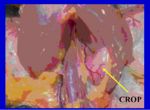Difference between revisions of "Crop - Anatomy and Physiology"
Jump to navigation
Jump to search
m |
|||
| Line 1: | Line 1: | ||
| − | + | {{toplink | |
| + | |backcolour =BCED91 | ||
| + | |linkpage =Alimentary - Anatomy & Physiology | ||
| + | |linktext =Alimentary System | ||
| + | |maplink = Alimentary (Concept Map)- Anatomy & Physiology | ||
| + | |pagetype =Anatomy | ||
| + | |sublink1=Avian Digestive Tract - Anatomy & Physiology | ||
| + | |subtext1=AVIAN DIGESTIVE TRACT | ||
| + | }} | ||
| + | <br> | ||
==Introduction== | ==Introduction== | ||
Revision as of 22:04, 2 September 2008
|
|
Introduction
The crop is a food storage device present in avian species. It is usually used when the muscular stomach (gizzard) is full. The crop also softens food.
It is a useful tool for avian veterinarians and owners for assessing when the bird last ate and it is especially important to ensure young chicks always have full crops. It is also a common site for impactions and surgical entry to remove foreign bodies.
Structure and Function
- Muscular chamber
- Fusiform enlargement of the oesophagus
- Thoracic inlet of ventral wall of oesophagus
- Bulges and lies against the breast muscles
Innervation
- Vagus nerve (CN X)
Species Differences
- Crop small in ducks and geese
- Crop much larger and muscular in seed eating birds
- Pigeons have epithelial cells in their crop sensitive to prolactin which slough when chicks (squabs) hatch producing crop milk
- Owls have no storage facility in their crops, so produce a pellet of indigestible material after every meal
